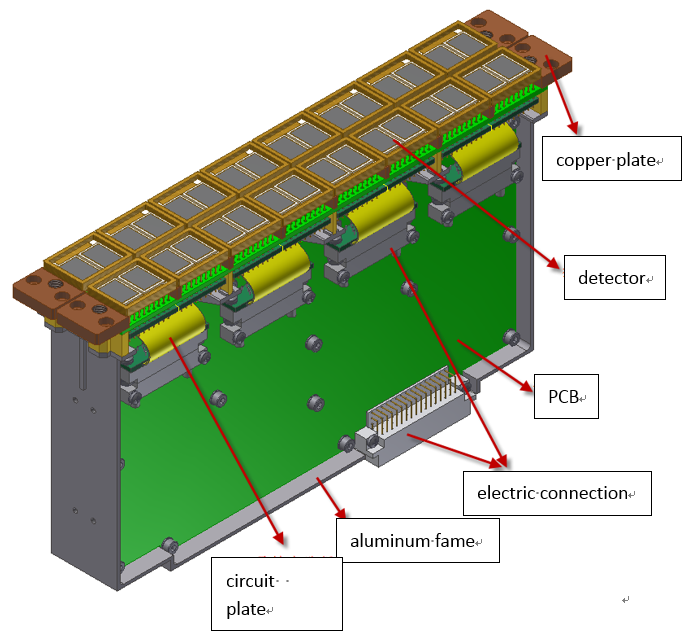Medium energy X-ray telescope (ME)
The overview of Insight-HXMT/ME is taken from Cao et al (2020). ME is designed to describe the X-ray radiation properties of the X-ray source in the medium X-ray band, which is helpful to study the variability in the multi-band and the spectrum in the broad X-ray band of the source (coupled with HE and LE). It covers 5-30 keV and displays energy resolution of about 3 keV, total geometrical area of 952 cm2, and main FOV of 1°×4°(FWHM).
ME consists of three detector boxes (MED1,MED2,MED3) and a power-control box (MEB).ME detectors consist of some Si-PIN arrays, divided into nine independent detector-units, with three units constituting one detector box. The collimator is installed on the top of the detector. A detector unit is further divided into six detector modules, each of which contains 32 Si-PIN detectors. To obtain high energy resolution with lower noise, Si-PIN detectors should work in low temperature. The in-orbit shade cover serves as a heat conductor, transmitting the detector heat to the radiative surface to ensure the detector temperature lower than -10 ℃.
Fig. 1 displays the structure of ME detector, including the radiative cooling panel, collimator and some plug-in components.

Fig. 1 The structure of the ME detector case.
The radiative cooling panel, contacting with the detector-component, can transmit the detector heat to the radiative surface to ensure the detector temperature ranging from -40 to -10 ℃. The Si-PIN detector is designed with the thickness of about 1 mm, and pixel scale of 56 mm2. When X-ray photons reach the detector base, X-ray photons lose all or part energies through photoelectric and Compton processes, which induce the formation of the electron-vacancy pair. Due to the existence of the inner electric field, these electron-vacancy pairs would be collected by the electrodes, forming the electric signal. The energy resolution (FWHM) is ≤ 3keV@20keV in working temperature ranging from -40 to -10 ℃.
The collimator is designed to set a limit on the FOV of the telescope. ME collimators involve large and small FOVs, which facilitate the background analyses. There are 54 detector modules, 45 of which are covered by collimators with the FOV of 1°×4°. A detector with a small FOV shows high spatial resolution and low probability of source contamination, and is applicable to observe point sources and diffuse sources with a small scale; especially in the scanning observations, the detector displays the same observation advantage. Six modules adopt collimators with the large FOV of 4°×4°, displaying large FOV area, which is helpful to search for and further observe diffuse sources. The other three modules are equipped with blocked collimators, which can measure the background events of the leaked sources and charged particles. Fig. 2 shows one unit of ME collimator.

Fig. 2 One unit of ME collimator
The pixel area of a Si-PIN detector is positively correlated with electric capacity, and the latter is positively correlated with the noise of the electric charge amplifier. In order to keep the energy resolution of the system, the area of the detector should be smaller than some value. However, due to the physical requirement, the area of a single-pixel detector should be larger than a value, to avoid the complexity of the readout electronic circuit and high power-consumption of the system. Eventually, the scale of the pixel is chosen as about 50 mm2, i.e., 12.5 mm×4.5 mm (56.25 mm2), after many trials. At present, there are 54 ME modules, and 32 detector pixels in each module, all of which is read-out by one VA32-TA6 chip. That is, there are 1728 Si-PIN detector pixels with the area of 952 cm2. In each ME box, there is a collimator installed with the radioactive source, which is applied for calibrating the energy resolution and signal amplitude of the in-orbit calibration detector. In the detection energy range of ME sub-system (5-30 keV), the in-orbit calibration adopts the radioactive source 241Am. That is, based on the radiation at 17.8 keV, the count rate should be 16, and the activity of radioactive source is 1μCi.
Each ME detector box has 9 independent plug-in components, and each component possesses two independent modules. There are 16 Si-PIN detector packages, and each package contains 4 Si-PIN pixels, adhered to the plug-in copper plate. The shell of the detector is ceramics, and its top is covered with an aluminum alloy frame with tantalum foils inserted inside and Be windows. Fig. 3 shows ME plug-in component.

Fig. 3 he structure of one MED plug-in component
